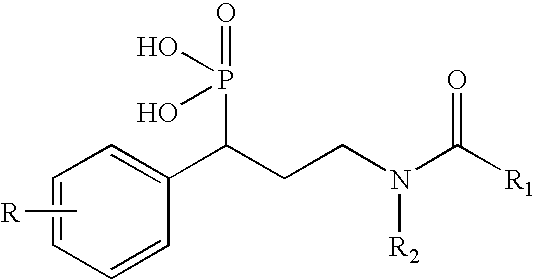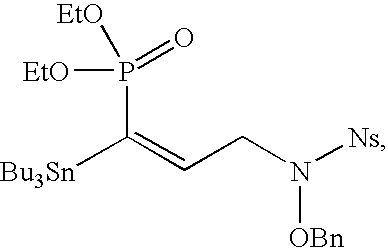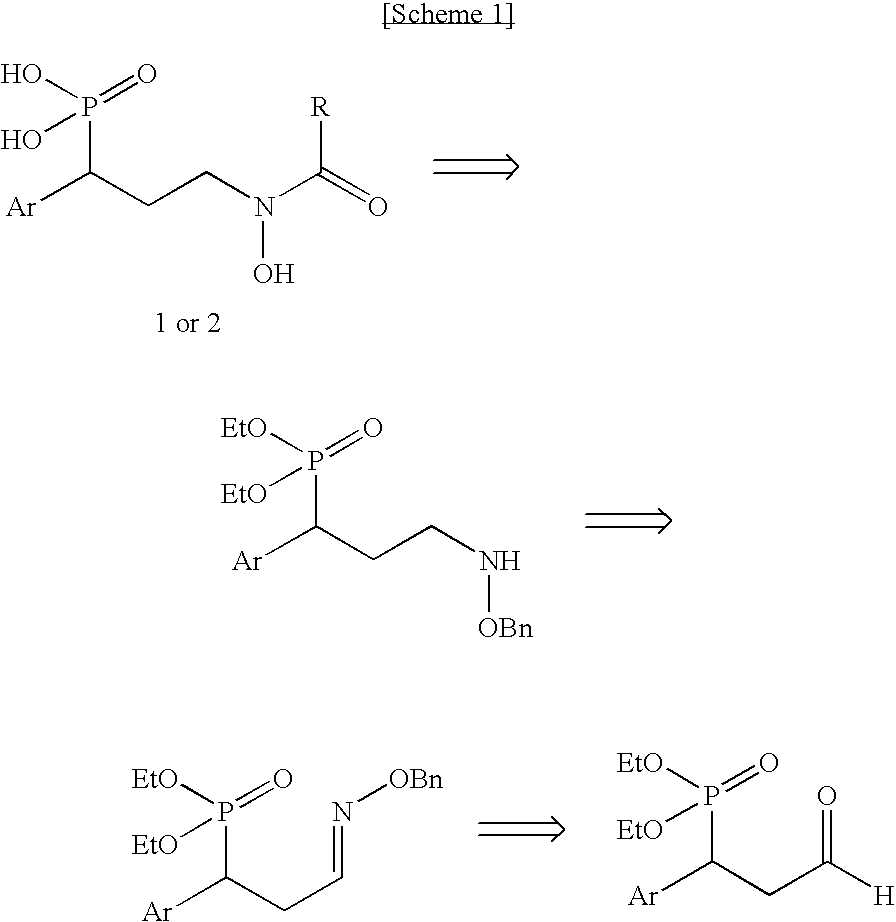Organophosphoric derivatives useful as anti-parasitic agents
a technology of organophosphoric derivatives and parasitic agents, which is applied in the field of new substituted organophosphoric derivatives, can solve the problems of short plasma half-life and moderate resorption rate of fosmidomycin, and achieve the effect of convenient production
- Summary
- Abstract
- Description
- Claims
- Application Information
AI Technical Summary
Benefits of technology
Problems solved by technology
Method used
Image
Examples
example 1
Preparation of Organophosphoric Acid Compounds
[0160]A. Using the Aldehyde Synthon Route
[0161]Retro-synthetic analysis toward the synthesis of the desired phosphonic acid compounds is depicted in scheme 1 below, wherein Ar designates an aryl group. 3-aryl-3-phosphoryl-propanal was found to be a convenient precursor for this synthetic method.
[0162]
[0163]More specifically, two synthetic pathways toward the aldehyde synthon were explored, as shown in scheme 2 below. The first route started from allyl bromide which upon Arbusow reaction with the appropriate diethyl benzyl-phosphonate in the presence of n-BuLi, afforded intermediates 4a,b in 97% and 33% yield, respectively. Oxidation of 4a,b to the vicinal cis-diol with osmium tetraoxide in the presence of 4-methylmorpholine N-oxide was more preferable than an ozonolytic reaction. The vicinal diol was subsequently cleaved by sodium periodate, thus providing aldehydes 7a,b which were used in the next step without further purification.
[0164...
example 2
Biological Evaluation of α-Phenyl Phosphonic Acid Derivatives
[0559]The in vitro anti-malarial activity of some of the compounds prepared in example 1 was determined as follows. Intraerythrocytic stages of the Plasmodium falciparum strains 3D7 and Dd2 were respectively incubated with serial dilutions of the relevant compounds and the viability of the parasites was assessed by their ability to incorporate [3H]hypoxanthine into DNA. Inhibition results were expressed as IC50. Fosmidomycin and FR900098 were included in this experimental procedure as reference compounds.
[0560]The tested compounds significantly surpassed the activity of fosmidomycin in the inhibition of parasite growth, as shown in the following table.
[0561]Compound 1e emerged as a very promising anti-malarial drug in this series. Its in vitro antimalarial activity indicated that it is twelve-fold more active than fosmidomycin and also exceeds the activity of FR900098, the most potent analogue known to date. Apparently, th...
PUM
| Property | Measurement | Unit |
|---|---|---|
| optical purity | aaaaa | aaaaa |
| optical purity | aaaaa | aaaaa |
| optical purity | aaaaa | aaaaa |
Abstract
Description
Claims
Application Information
 Login to View More
Login to View More - R&D
- Intellectual Property
- Life Sciences
- Materials
- Tech Scout
- Unparalleled Data Quality
- Higher Quality Content
- 60% Fewer Hallucinations
Browse by: Latest US Patents, China's latest patents, Technical Efficacy Thesaurus, Application Domain, Technology Topic, Popular Technical Reports.
© 2025 PatSnap. All rights reserved.Legal|Privacy policy|Modern Slavery Act Transparency Statement|Sitemap|About US| Contact US: help@patsnap.com



